Other News in Art
We at Fine Art Touch love Italian Renaissance art, but we also understand that there are other things happening in the art world. Here are just a few.
Update on Aztec Finds: Largest Aztec Idol Ever Found
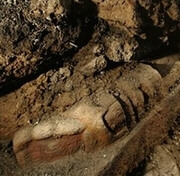 As it turns out, the 11 foot long stone slab found on 10/04/2006 with the much publicized Aztec altar may actually be of greater historical significance than the altar itself. Archaeologists now believe the slab is the largest Aztec idol ever found, acclaiming the giant stone idol as one of the greatest finds in Mexico. The Aztec Calendar stone, the Piedra del Sol, also found on the site of the Templo Mayor complex outweighs the monolithic idol slab, but the length of the slab is longer than the radius of the Calendar Stone. Anthropologist Anvaro Barrera cautions patience to those waiting to see what is found and what those finds may mean. It is expected that excavation will be complete in about a month. As it turns out, the 11 foot long stone slab found on 10/04/2006 with the much publicized Aztec altar may actually be of greater historical significance than the altar itself. Archaeologists now believe the slab is the largest Aztec idol ever found, acclaiming the giant stone idol as one of the greatest finds in Mexico. The Aztec Calendar stone, the Piedra del Sol, also found on the site of the Templo Mayor complex outweighs the monolithic idol slab, but the length of the slab is longer than the radius of the Calendar Stone. Anthropologist Anvaro Barrera cautions patience to those waiting to see what is found and what those finds may mean. It is expected that excavation will be complete in about a month.
Aztec Altar Found in the Heart of Mexico City
 10/04/2006 - A significant archaeological discovery was found last weekend in downtown Mexico City. It appears to be an Aztec altar and an 11 foot long slab from the 15th century, part of the Templo Mayor pyramid complex. The Templo Mayor was destroyed by the Spanish conquistodores in 1521 to use as building materials for their capital. The altar features a frieze of Tlaloc, the rain god, and the slab may be covering the entrance to a subterranean chamber. The slab is not fully excavated. The remains of the Templo Mayor were only discovered in 1978 when electricity workers found an 8 ton carving of an Aztec goddess. The Tlaloc altar is the first major find in 28 years 10/04/2006 - A significant archaeological discovery was found last weekend in downtown Mexico City. It appears to be an Aztec altar and an 11 foot long slab from the 15th century, part of the Templo Mayor pyramid complex. The Templo Mayor was destroyed by the Spanish conquistodores in 1521 to use as building materials for their capital. The altar features a frieze of Tlaloc, the rain god, and the slab may be covering the entrance to a subterranean chamber. The slab is not fully excavated. The remains of the Templo Mayor were only discovered in 1978 when electricity workers found an 8 ton carving of an Aztec goddess. The Tlaloc altar is the first major find in 28 years
Ancient Celtic Art: Illuminated Manuscript Found in Peat Bog
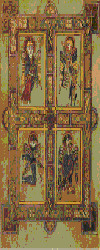 A 1,200 year old holy book was found on Thursday, July 20, 2006 in a peat bog in Ireland, and scholars are excited to see what it may reveal. This leather-bound medieval manuscript with Irish Celtic art has been dated from 800-1,000 AD and contains about twenty illustrated pages on leather vellum. Currently stored in refrigeration, it will take years of painstaking study before it can be put on public display. Quick thinking by the landowner who found it certainly saved the manuscript from further deterioration. When bulldozing his property, he saw the manuscript, recognized what it was, and promptly re-covered it with damp soil preventing it from drying out to preserve it for proper excavation. This new discovery has been likened to the finding the Dead Sea Scrolls. A 1,200 year old holy book was found on Thursday, July 20, 2006 in a peat bog in Ireland, and scholars are excited to see what it may reveal. This leather-bound medieval manuscript with Irish Celtic art has been dated from 800-1,000 AD and contains about twenty illustrated pages on leather vellum. Currently stored in refrigeration, it will take years of painstaking study before it can be put on public display. Quick thinking by the landowner who found it certainly saved the manuscript from further deterioration. When bulldozing his property, he saw the manuscript, recognized what it was, and promptly re-covered it with damp soil preventing it from drying out to preserve it for proper excavation. This new discovery has been likened to the finding the Dead Sea Scrolls.
Stolen Art Recovered: Cellini's Saltcellar of Francis I
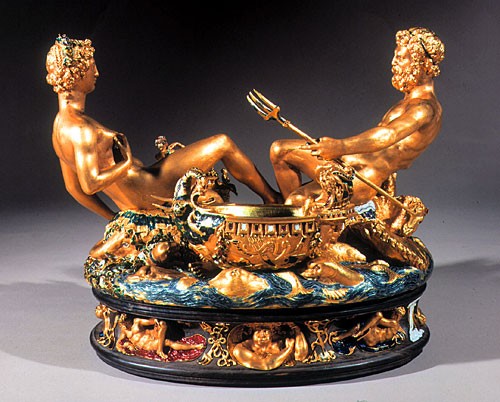 VIENNA, Austria VIENNA, Austria 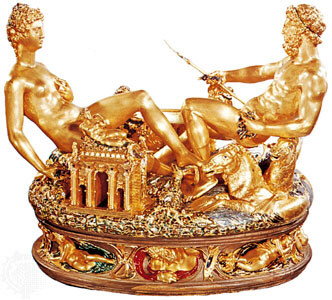 Spectacular news for art lovers everywhere is the recovery of the 16th century masterpiece, Saliera of Francis I, a magnificent work of gold and enamel of 1540-43 by Florentine Renaissance/ Mannerist goldsmith, artist extraordinaire, Benvenuto Cellini. 10 inches tall and valued at $65 million, the Saliera (Saltcellar) was buried in a forest near Vienna after it was stolen in 2003 from Vienna's Art History Museum. According to the thief himself, Robert Mang, an alarm specialist, the theft was nothing more than a prank. The work was recovered January 20, 2006, but this prank will cost Austrian Mang four years in prison. The Saltcellar depicts the Greek god of the sea, Neptune, and the goddess of agriculture, Ceres, appropriate culinary images to grace the dining table of the King of France. The importance of the king's guests was revealed by how close they were seated to the Saltcellar. This is the artist's sole remaining authenticated gold work. Cellini's Saliera was compared by the museum to be equivalent to Leonardo's Mona Lisa. Extraordinarily talented, but not particularly modest, Cellini would have agreed with this assessment, as does this author. --Brenda Harness, Art Historian Spectacular news for art lovers everywhere is the recovery of the 16th century masterpiece, Saliera of Francis I, a magnificent work of gold and enamel of 1540-43 by Florentine Renaissance/ Mannerist goldsmith, artist extraordinaire, Benvenuto Cellini. 10 inches tall and valued at $65 million, the Saliera (Saltcellar) was buried in a forest near Vienna after it was stolen in 2003 from Vienna's Art History Museum. According to the thief himself, Robert Mang, an alarm specialist, the theft was nothing more than a prank. The work was recovered January 20, 2006, but this prank will cost Austrian Mang four years in prison. The Saltcellar depicts the Greek god of the sea, Neptune, and the goddess of agriculture, Ceres, appropriate culinary images to grace the dining table of the King of France. The importance of the king's guests was revealed by how close they were seated to the Saltcellar. This is the artist's sole remaining authenticated gold work. Cellini's Saliera was compared by the museum to be equivalent to Leonardo's Mona Lisa. Extraordinarily talented, but not particularly modest, Cellini would have agreed with this assessment, as does this author. --Brenda Harness, Art Historian
Stolen Art Still Missing: Da Vinci's Madonna of the Yarnwinder
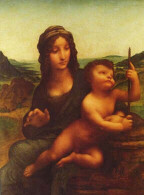 This fine art work by Italian Renaissance painter, Leonardo da Vinci, was in the private collection of the Duke of Buccleuch in Scotland until it was stolen in 2003…an unfortunate loss for art history and art historians since so few authentic Leonardo paintings exist today. Most likely it was commissioned in 1501 by the Secretary of State for King Louis XII of France, Florimund Robertet. This is a fine art image of the Madonna and Child with the Christ Child looking at a crucifix-shaped yarnwinder. The dark modeling of the Madonna and Child evidences Leonardo’s expert use of his inventive, smoky, sfumato technique to achieve the perception of depth. --Brenda Harness, Art Historian This fine art work by Italian Renaissance painter, Leonardo da Vinci, was in the private collection of the Duke of Buccleuch in Scotland until it was stolen in 2003…an unfortunate loss for art history and art historians since so few authentic Leonardo paintings exist today. Most likely it was commissioned in 1501 by the Secretary of State for King Louis XII of France, Florimund Robertet. This is a fine art image of the Madonna and Child with the Christ Child looking at a crucifix-shaped yarnwinder. The dark modeling of the Madonna and Child evidences Leonardo’s expert use of his inventive, smoky, sfumato technique to achieve the perception of depth. --Brenda Harness, Art Historian
Raphael's Baldassare Castiglione rides again!
 With the arrival of one of Raphael's most beloved portraits, that of Italian Renaissance writer and courtier Baldassare Castiglione, comes a 3d animated resurrection of said courtier as a museum tour guide. In a three-year partnership, the High Museum of Art in Atlanta and the Louvre in Paris will present a new exhibition called Louvre AtlantaTM. The Louvre will send hundreds of art works to the High Museum in an exhibition that will run from October 2006 through 2009. According to the High's website, the purpose of the partnership will "trace the history and development of the Louvre from the 17th century through the present. The three exhibitions in year one will focus on the genesis of the royal collection of the pre-Revolutionary Régime—the works collected by the Kings before the Louvre was converted from a palace to a museum during the late 18th century and that make up the heart of the Louvre’s collections." It should be interesting. --Brenda Harness, Art Historian With the arrival of one of Raphael's most beloved portraits, that of Italian Renaissance writer and courtier Baldassare Castiglione, comes a 3d animated resurrection of said courtier as a museum tour guide. In a three-year partnership, the High Museum of Art in Atlanta and the Louvre in Paris will present a new exhibition called Louvre AtlantaTM. The Louvre will send hundreds of art works to the High Museum in an exhibition that will run from October 2006 through 2009. According to the High's website, the purpose of the partnership will "trace the history and development of the Louvre from the 17th century through the present. The three exhibitions in year one will focus on the genesis of the royal collection of the pre-Revolutionary Régime—the works collected by the Kings before the Louvre was converted from a palace to a museum during the late 18th century and that make up the heart of the Louvre’s collections." It should be interesting. --Brenda Harness, Art Historian
New Excavation: Roman "Reversed" Mosaic of Bacchus
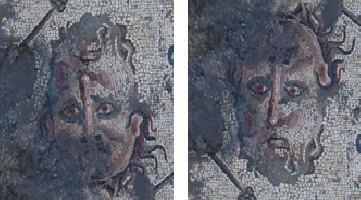 This is Roman illusionism at its finest and probably stunned workmen who unearthed it! This 3rd century fire-damaged mosaic floor was discovered in May, 2006, in an excavation that was exploring a renovation to a 1st century AD Italian villa at Palazzo Morgano, an ancient site. Depicted is an image assumed to be that of the Roman god Bacchus, so attributed because certain cult objects of the god are represented in the same panel. Bacchus can be viewed as two distinctly separate images when seen from opposite viewpoints. Decorating the dining room of some wealthy Roman, Bacchus appears one way as a beardless young man, and from another view as a bearded, bald old man. According to Dr. Mark Merrony, "the image would have made visual sense to the viewer entering into the dining area as well as when seated. This style of representation, heads upside-down to each other, often with youths and satyrs, is commonly found on engraved ring intaglios, but is hitherto unknown in Roman mosaics." Late Italian Renaissance/Mannerist painter, Giuseppe Arcimboldo, would take this same idea of representation to a new level with his fantastic, illusionistic portraits. --Brenda Harness, Art Historian This is Roman illusionism at its finest and probably stunned workmen who unearthed it! This 3rd century fire-damaged mosaic floor was discovered in May, 2006, in an excavation that was exploring a renovation to a 1st century AD Italian villa at Palazzo Morgano, an ancient site. Depicted is an image assumed to be that of the Roman god Bacchus, so attributed because certain cult objects of the god are represented in the same panel. Bacchus can be viewed as two distinctly separate images when seen from opposite viewpoints. Decorating the dining room of some wealthy Roman, Bacchus appears one way as a beardless young man, and from another view as a bearded, bald old man. According to Dr. Mark Merrony, "the image would have made visual sense to the viewer entering into the dining area as well as when seated. This style of representation, heads upside-down to each other, often with youths and satyrs, is commonly found on engraved ring intaglios, but is hitherto unknown in Roman mosaics." Late Italian Renaissance/Mannerist painter, Giuseppe Arcimboldo, would take this same idea of representation to a new level with his fantastic, illusionistic portraits. --Brenda Harness, Art Historian
Stolen Art Recovered: Munch's The Scream
 OSLO, Norway – The stolen art works, The Scream and Madonna by Edvard Munch, will return at long last to the public eye after two years in absentia. But this story unlike many other tales of stolen art has a happy ending. The Scream and Madonna were snatched off the wall in broad daylight by masked gunmen in front of a group of shocked visitors at the Munch Museum in Oslo on Aug. 22, 2004. The two stolen art works are now confirmed genuine, suffering little damage despite fears by the museum and art lovers all over the world. A "successful police action" on August 31, 2006 was responsible for recovery of the paintings according to Iver Stensrud, lead police inspector for the investigation. Executed in an Expressionist style, The Scream is Munch's best known work. Both stolen art works were painted in 1893. --Brenda Harness, Art Historian OSLO, Norway – The stolen art works, The Scream and Madonna by Edvard Munch, will return at long last to the public eye after two years in absentia. But this story unlike many other tales of stolen art has a happy ending. The Scream and Madonna were snatched off the wall in broad daylight by masked gunmen in front of a group of shocked visitors at the Munch Museum in Oslo on Aug. 22, 2004. The two stolen art works are now confirmed genuine, suffering little damage despite fears by the museum and art lovers all over the world. A "successful police action" on August 31, 2006 was responsible for recovery of the paintings according to Iver Stensrud, lead police inspector for the investigation. Executed in an Expressionist style, The Scream is Munch's best known work. Both stolen art works were painted in 1893. --Brenda Harness, Art Historian
For more information on Italian Renaissance Art and recommended books, click here.
|
 VIENNA, Austria
VIENNA, Austria